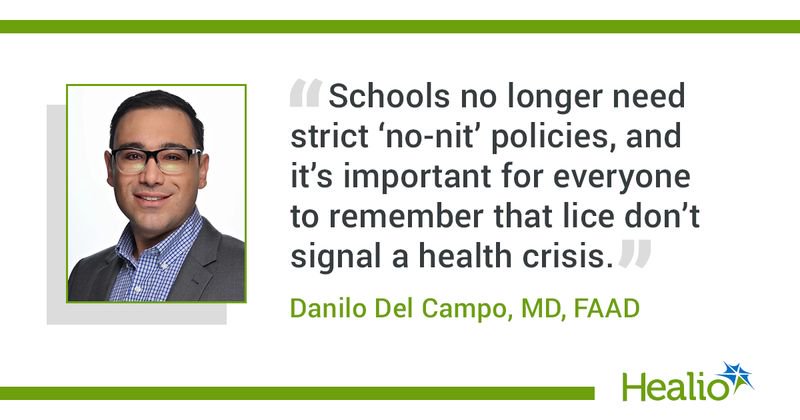No changes to CDC guidelines recommending children with lice do not need to leave school
Key takeaways:
- Contrary to media reports, the CDC has not changed its guidelines on sending children with head lice home from school.
- Danilo Del Campo, MD, FAAD, spoke with Healio on why to follow this recommendation.
As kids return to school, the CDC has reminded the public that children with lice do not need to cut their school day short and be sent home early.
In the past, finding a louse on a child’s scalp resulted in frantically sending the student home to avoid spreading this contagious infestation. However, over the past decade, the CDC has instructed parents and teachers not to send children home early from school following the discovery of lice.

Contrary to recent news reports published by popular media outlets, this guideline has remained unchanged, as the CDC has reminded the public on its website.
According to Danilo Del Campo, MD, FAAD, a dermatologist at the Chicago Skin Clinic, these guidelines are consistent with health care findings.
“Lice are definitely a nuisance but they don’t spread disease or cause any major health issues,” Del Campo told Healio. “The CDC recognizes that by the time lice are found, they’ve probably been present for weeks without causing any real harm, so sending kids home immediately isn’t necessary.”
According to Del Campo, lice cannot jump or fly, they simply crawl. As a result, it is difficult for them to spread quickly in a classroom setting.
“As long as treatment starts that evening, kids can finish the school day without putting others at risk,” he said.
While many exhausted parents believe that every louse must be exterminated before allowing their child to return to school, this is also not the case.
“Children can return to school the very next day after starting treatment,” Del Campo explained. “There’s no need to wait until every last nit is gone, as long as the child is being actively treated.”
Although children are unlikely to being rubbing their heads together in the classroom, it is important to quickly catch and treat lice. Because children aged 3 to 11 are most commonly affected by headlice, environments such as preschools, day camps and elementary schools can make it easier for lice to spread.
“Kids who share hats, hairbrushes or have sleepovers are also more at risk, though sharing items is not the most common way for lice to spread,” Del Campo said. “And just to clear things up — head lice don’t care about how clean or messy your hair is; anyone can get them!”
Parents with children this age should be on the lookout for the symptoms of lice, the most prominent being itching, although that could take weeks to present itself. Red bumps or sores from scratching may also be a red flag and, of course, the presence of tiny eggs, also known as nits, stuck to the child’s hair certainly signals a case of head lice.
“Over-the-counter treatments like permethrin and pyrethrin-based shampoos are usually the go-to options for treating head lice,” Del Campo advised. “Just make sure to follow the instructions carefully, and if needed, a second round of treatment might be required 7 to 10 days later.”
Parents should also make sure to comb though children’s hair to remove any nits as these could hatch and cause a reinfestation. If none of these treatment options work, a prescription such as malathion or ivermectin may be recommended.
“If you’ve ever thought about declaring a ‘lice emergency,’ don’t worry — there’s a solution for everyone!” Del Campo said.
Despite the CDC’s reminder, parents and teachers may still panic over the presence of lice on their child or in the classroom; however, Del Campo assures that the CDC’s advice is sound and should be followed.
“Schools no longer need strict ‘no-nit’ policies, and it’s important for everyone to remember that lice don’t signal a health crisis,” he told Healio. “The main goal is to keep education uninterrupted while treating the problem at home — quick and simple!”
Reference:
- About head lice. https://www.cdc.gov/lice/about/head-lice.html. Published June 4, 2024. Accessed Sept. 9, 2024.
For more information:
Danilo Del Campo, MD, FAAD, can be reached at doctor@chicagoskinclinic.com.
